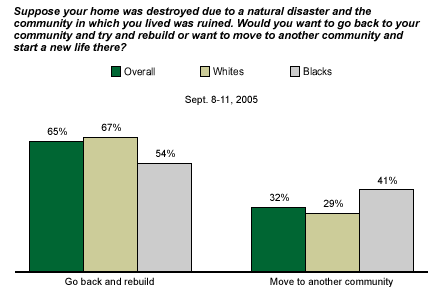On his most recent trip to the hurricane-ravaged Gulf Coast, President George W. Bush reaffirmed his confidence that New Orleans -- one of the nation's largest cities and most vital seaports -- would rise again. "Out of this rubble is going to come something good," the president said. "Out of this devastation will come a new city."
In a Sept. 5-6 Â鶹´«Ã½AV Poll*, nearly two-thirds of Americans said they think New Orleans should be rebuilt as a major city. But in what ways will New Orleans be new? While it is among the nation's largest cities, more than two-thirds of New Orleans residents are black, and the city is among the most impoverished in the nation. Census figures reveal that people have been leaving New Orleans proper in droves since the 1960s, taking jobs and personal wealth with them. Whites flocked to suburbs and surrounding areas, more or less segregating the city by race and income.
Many people, from government officials and philanthropic groups to former New Orleans city planning director Kristina Ford, see the destruction as an opportunity to create a more integrated Crescent City. Â鶹´«Ã½AV recently asked Americans nationwide** how successful they think government planners would be in rebuilding the Big Easy in such a way that neighborhoods would not be as segregated by race and class as they were before Katrina. Americans are dubious about the prospects for this; only 36% believe such an effort would be very (6%) or somewhat (30%) successful.

However, black Americans are more optimistic than white Americans on this question. Almost half of blacks (46%) say that government planners would succeed in making the city more integrated, while only a third (32%) of whites say they would be successful.
If You Rebuild It, Will They Come?
Â鶹´«Ã½AV, in conjunction with the American Red Cross, recently asked displaced victims of Hurricane Katrina who applied for disaster relief whether they would return to the community in which they lived before Hurricane Katrina hit. Four in 10 relief applicants who lived in the city of New Orleans prior to Hurricane Katrina say they will definitely (16%) or probably (23%) not return.
How many Americans share that reluctance to go back? That is, if a natural disaster destroyed their homes and left their communities in ruins, how many say they would return and try to rebuild and how many would move somewhere else and start over?
Two-thirds of Americans say they would go back and try to rebuild, while 32% would move to another area and start their new lives there. Again, there are differences by race. While majorities of blacks and whites would go back and rebuild, whites are more likely than blacks to say they'd go back. Sixty-seven percent of whites say they would try to rebuild their communities, compared with 54% of blacks.

*Results are based on telephone interviews with 609 national adults, aged 18 and older, conducted Sept. 5-6, 2005. For results based on the total sample of national adults, one can say with 95% confidence that the margin of sampling error is ±4 percentage points.
**Results are based on telephone interviews with 262 blacks, aged 18 and older, conducted Sept. 8-11, 2005, some of which were drawn from Â鶹´«Ã½AV's Sept. 8-11 national sample and some of which were drawn from a special black oversample. The combined sample of blacks is weighted to be representative of U.S. blacks. For results based on the total sample, one can say with 95% confidence that the margin of sampling error is ±7 percentage points.
Results for the sample of 848 non-Hispanic whites, aged 18 and older, are based on telephone interviews conducted Sept. 8-11, 2005, drawn from the national sample poll. For results based on the total sample, one can say with 95% confidence that the margin of sampling error is ±4 percentage points.
In addition to sampling error, question wording and practical difficulties in conducting surveys can introduce error or bias into the findings of public opinion polls.
The poll did not dial into some of the areas of Louisiana and Mississippi that were declared federal disaster areas following Hurricane Katrina. This amounts to about 0.75% of the U.S. population.
